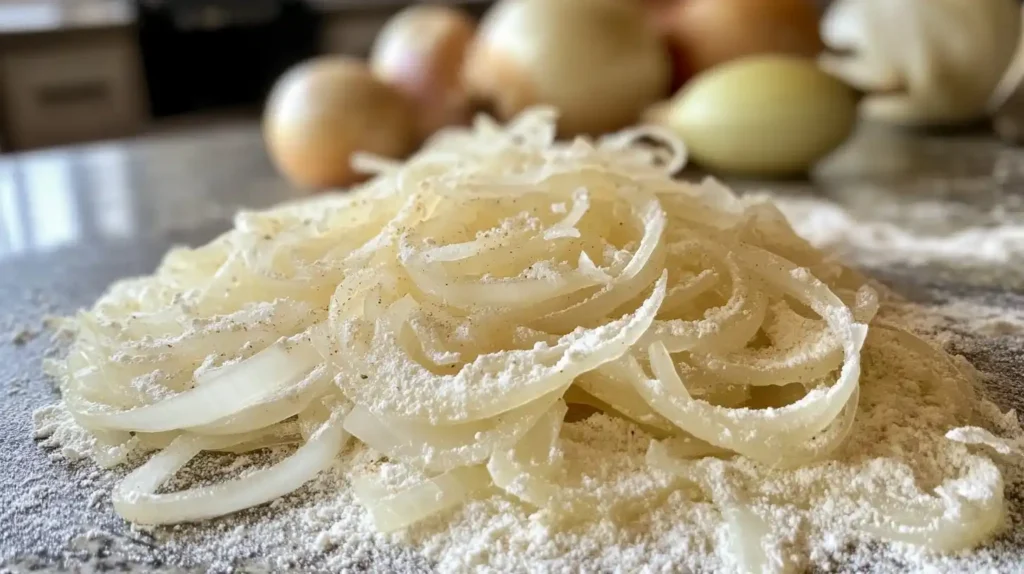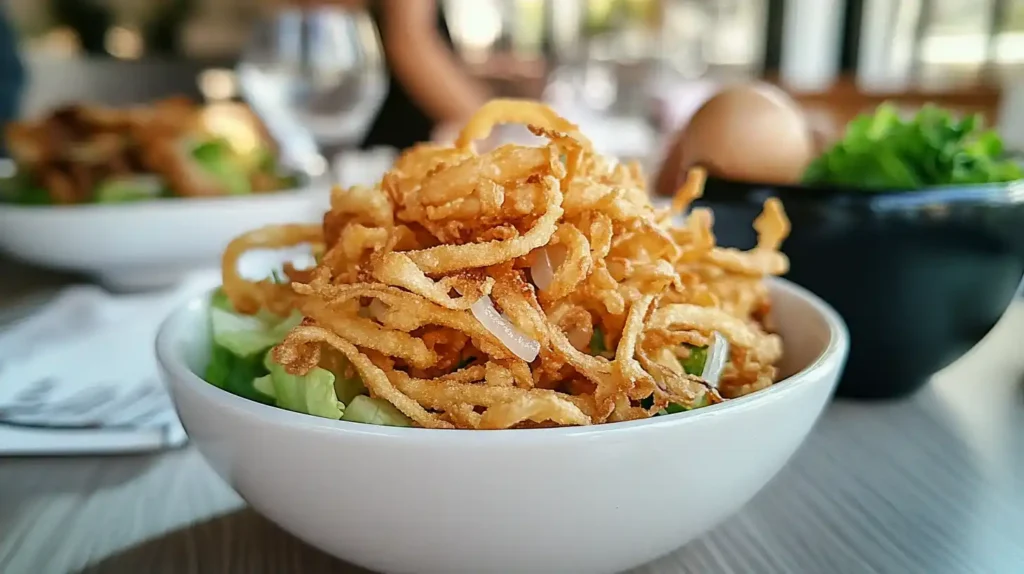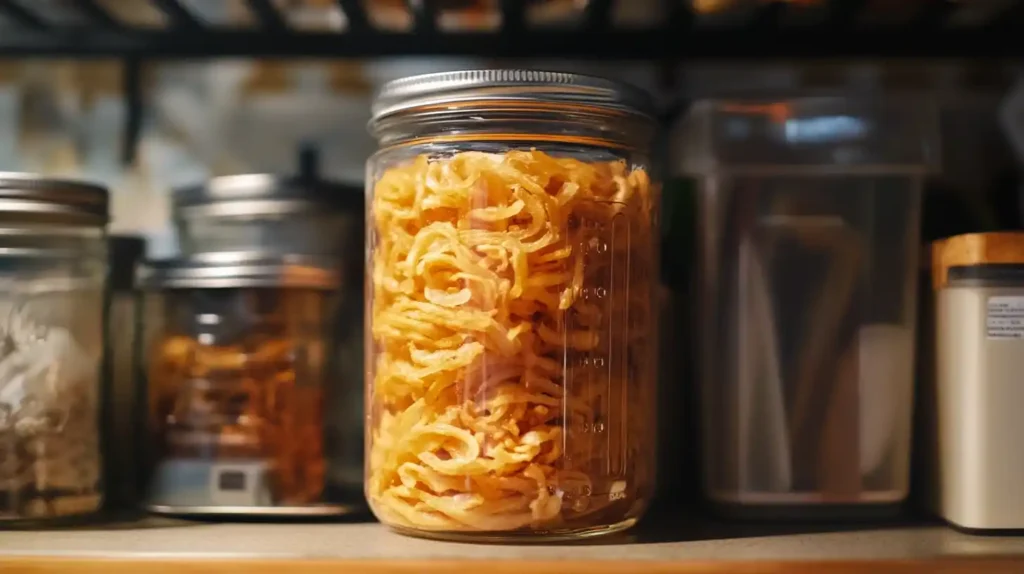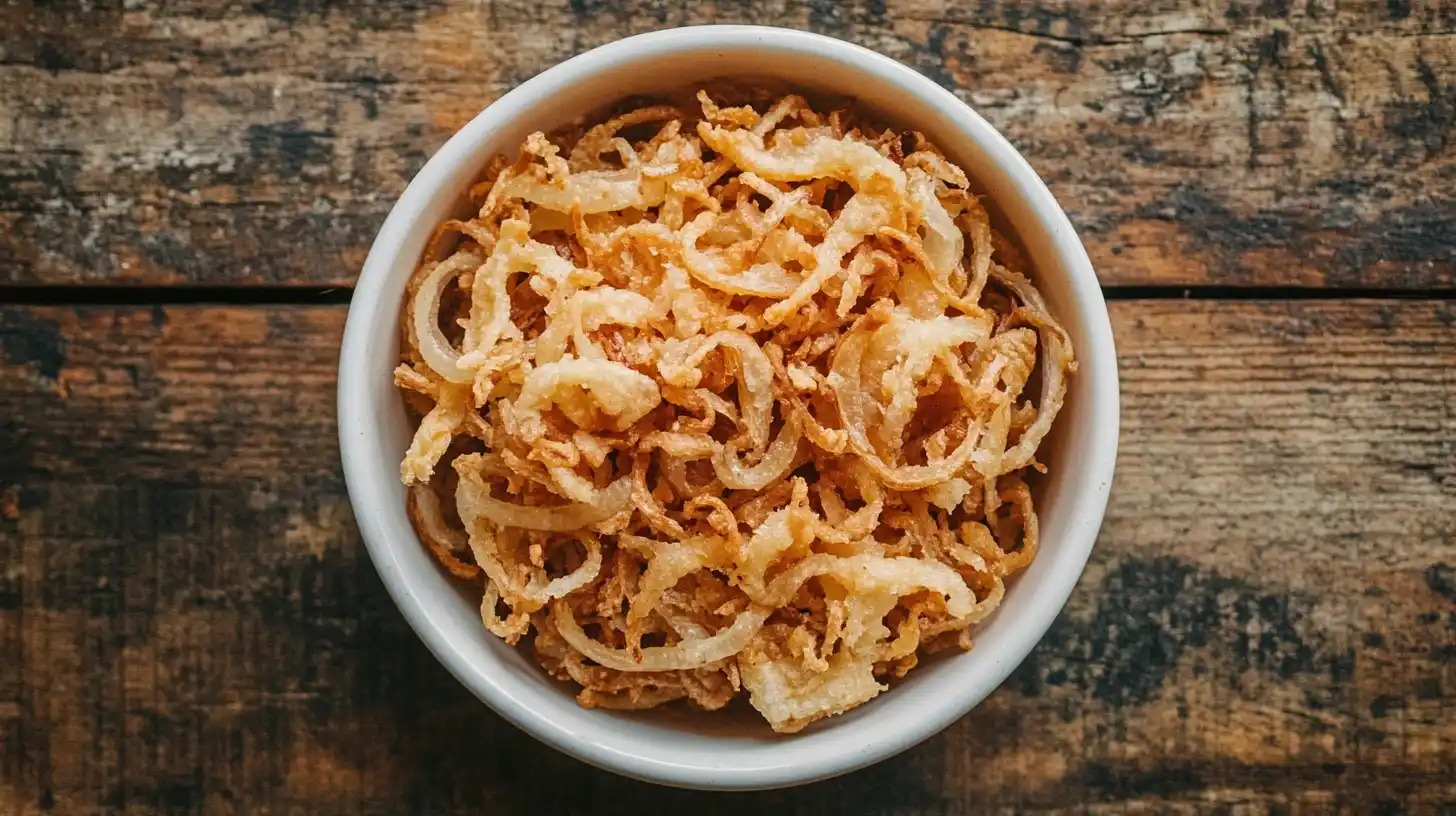French fried onions are a staple ingredient that adds crunch and flavor to countless dishes. Whether they’re used as a topping for casseroles or a garnish for soups, these crispy onions elevate meals in a simple yet delicious way. But what exactly are they made of? Let’s explore their ingredients, preparation methods, and why people love them so much.
Table of contents

What Are French Fried Onions?
The ingredients in French fried onions are simple, yet each plays a vital role in delivering the perfect crunch and flavor. Here’s a closer look:
- Onions
- Most recipes and brands use yellow or white onions. Yellow onions have a mild sweetness that complements their crispy coating, while white onions offer a sharper flavor.
- Freshness matters! The onions need to be firm and juicy to maintain their structure after frying.
- Flour
- Wheat flour is the standard choice. It forms the batter that sticks to the onion slices, creating a crispy crust when fried.
- Gluten-free options like rice flour or almond flour are becoming more popular. These alternatives work well for those avoiding wheat and provide a lighter texture.
- Oil
- Most store-bought options use palm oil because it’s stable at high temperatures. However, homemade versions often use healthier options like canola, sunflower, or avocado oil.
- For a healthier twist, some people bake or air-fry the onions instead of deep-frying them.
- Salt and Dextrose
- Salt enhances the natural onion flavor.
- Dextrose, a type of sugar, adds a touch of sweetness that balances the savory taste. It also helps the onions brown evenly during frying.
Homemade vs. Store-Bought Ingredients
Making French fried onions at home gives you complete control over the ingredients used. This allows you to customize them to suit your taste or dietary needs. Homemade recipes often include:
- Milk: Onions are soaked in milk beforehand to mellow their sharpness and ensure the batter adheres well.
- Spices: Adding garlic powder, paprika, or black pepper to the flour mixture boosts the flavor.
- Oil Choices: Instead of palm oil, you can opt for oils that suit your dietary preferences or frying method.
Allergy and Dietary Considerations
- Many store-bought options contain wheat, which is not suitable for those with gluten intolerance. Look for gluten-free alternatives or make them at home with a different type of flour.
- Most French fried onions are free from pork products, gelatin, or alcohol. Always check the label to ensure it meets your dietary needs.
How Do You Make French Fried Onions?
The Process Behind the Crisp
Making French fried onions involves simple steps:
- Thinly slice onions.
- Coat them in seasoned flour.
- Fry them in hot oil until crispy.
For a healthier spin, air fryers can deliver similar results with significantly less oil. This method also allows for customization, such as reducing salt or adding spices like paprika.
Learn how to experiment with creative cooking by exploring The Ultimate Guide to Fettucini, which showcases innovative methods for traditional ingredients.
Industrial Production Process
- Slicing the Onions
- Factories start by selecting fresh yellow or white onions. These onions are peeled and sliced into thin rings or strips.
- Machines ensure uniform size, which helps the onions cook evenly.
- Coating with Batter
- The onion slices are dipped into a mixture of wheat flour, salt, and sometimes dextrose. This batter sticks to the onions, forming a light coating that crisps up during frying.
- Frying to Perfection
- The coated onions are deep-fried in palm oil at high temperatures. The frying process gives the onions their golden-brown color and signature crunch.
- To maintain consistency, temperature controls are used to ensure each batch cooks evenly.
- Cooling and Packaging
- After frying, the onions are cooled to retain their crunch. They are then packed in airtight containers or bags to preserve their freshness.
Homemade Method
Creating French fried onions at home allows you to add personal touches and experiment with flavors. Here’s a simple step-by-step guide:
- Prepare the Onions
- Peel and thinly slice your onions. You can use a mandoline for even slices.
- Soak the slices in milk for 5–10 minutes to reduce sharpness and improve batter adhesion.
- Mix the Coating
- Combine flour with your choice of seasonings. Common spices include garlic powder, paprika, and a pinch of pepper.
- Coat the Onions
- Take a handful of onion slices from the milk and toss them in the flour mixture. Shake off any excess.
- Fry the Onions
- Heat oil in a deep pan. When the oil reaches 350–375°F (175–190°C), fry the coated onions in small batches.
- Fry for 2–3 minutes until they turn golden and crispy. Avoid overcrowding the pan, as this can lower the oil temperature.
- Drain and Serve
- Place the fried onions on a paper towel to drain excess oil. Let them cool before serving or storing.
Alternative Cooking Methods
If you want a healthier option, try these methods:
- Air Frying: Coat the onions lightly with oil before air frying. This reduces the amount of fat while maintaining crispiness.
- Baking: Spread the coated onions on a baking sheet and bake at 400°F (200°C) for about 20 minutes, flipping halfway through.
Why Do People Love French Fried Onions?

What Makes Them So Popular?
French fried onions are more than just a garnish; they are a crunchy, flavorful ingredient that transforms meals. Their versatility and taste make them a kitchen favorite. Let’s explore why people love them so much.
1. They Add a Perfect Crunch
One of the biggest reasons for their popularity is their crunch. The crispy texture creates a delightful contrast in dishes. For instance, when added to a creamy casserole, they provide an exciting bite that keeps you coming back for more. This texture also pairs wonderfully with soft soups or salads, making every bite a little more satisfying.
Moreover, their ability to stay crispy, even in moisture-heavy dishes, ensures they retain their appeal from the first bite to the last.
2. The Flavor is Hard to Resist
The flavor of French fried onions strikes a balance between sweet and savory. The natural sweetness of onions combines with the saltiness of the batter to create a harmonious taste. Many brands also enhance the batter with spices like garlic powder or paprika, adding even more layers of flavor.
Additionally, their ability to complement a variety of cuisines makes them a versatile choice. Whether you’re cooking a classic American casserole or experimenting with Asian-inspired dishes, French fried onions fit right in.
3. They’re Incredibly Versatile
You can use French fried onions in countless ways. Here are some popular uses:
- Casseroles: They are the highlight of dishes like green bean casserole, especially during holiday feasts.
- Salads: A handful of crispy onions adds both flavor and crunch to leafy greens.
- Soups: As a garnish, they elevate creamy soups such as potato or mushroom.
- Burgers and Sandwiches: They add an irresistible crunch to handheld favorites.
- Creative Recipes: Chefs use them as pizza toppings or mix them into breading for chicken or fish.
Because they are so versatile, French fried onions often become a go-to ingredient for elevating everyday dishes.
Convenience and Customization: Perfect for Every Meal and Diet
1. Convenience Makes Them a Winner
Store-bought French fried onions are incredibly convenient. You don’t need to prep or cook them; just open the package and sprinkle them on your dish. This ease of use makes them perfect for busy weeknights or last-minute meal enhancements.
If you prefer making them at home, the process is straightforward and allows for customization. Homemade versions let you experiment with spices or opt for healthier cooking methods, such as baking or air frying.
2. Customization for Special Diets
Another reason why people love French fried onions is the ability to tailor them to their dietary needs. For example:
- Gluten-Free: Use almond or rice flour instead of wheat flour.
- Low-Fat: Air fry or bake them instead of deep frying.
- Low-Sodium: Reduce the amount of salt in the batter.
This adaptability ensures that everyone can enjoy them, regardless of dietary restrictions.
The Bottom Line
In summary, French fried onions are loved for their crunch, flavor, and versatility. They can turn ordinary meals into something memorable while being easy to use and adaptable for various diets. Whether you use them as a topping, mix them into recipes, or simply snack on them, they’re sure to win you over with their unique appeal.
Nutritional Insights to Consider
What Should You Know About Their Nutrition?
While French fried onions are delicious, it’s important to understand their nutritional content. Whether you’re enjoying them as a topping or a snack, knowing what’s inside can help you make healthier choices. Let’s break it down.
1. Calorie Content
- French fried onions are calorie-dense because they are deep-fried.
- A typical serving (about 2 tablespoons) contains approximately 45–60 calories.
- The calories come mainly from the frying oil and the coating.
2. Fat Content
- Most of the fat in French fried onions comes from the frying oil, like palm or canola oil.
- A serving can contain around 4–5 grams of fat, which includes saturated fats.
- Health-conscious consumers can opt for baked or air-fried versions to reduce fat intake.
3. Carbohydrates and Fiber
- The wheat flour used in the coating is the primary source of carbohydrates.
- A serving typically contains about 4–6 grams of carbohydrates.
- They are not a significant source of dietary fiber.
- Salt is a key ingredient in French fried onions, which contributes to their savory flavor.
- Depending on the brand, a serving can contain 60–100 mg of sodium.
- If you’re watching your sodium intake, homemade versions allow you to control the amount of salt.
5. Sugar Content
- Some brands use dextrose, a type of sugar, to enhance flavor and promote browning.
- While the amount is minimal, it’s worth noting for those managing their sugar intake.
6. Vitamins and Minerals
- Onions naturally contain small amounts of vitamins like Vitamin C and minerals like potassium.
- However, frying reduces these nutrients, so they don’t offer significant health benefits.
Tips for Making Healthier Choices
- Homemade Alternatives
- Use gluten-free or whole-grain flour for a healthier coating.
- Try air frying or baking instead of deep frying.
- Portion Control
- A little goes a long way. Use them as a topping rather than a snack to keep portions manageable.
- Check Labels
- Look for low-sodium or organic options when purchasing pre-made French fried onions.
Final Thoughts on Nutrition
While French fried onions are not a health food, they can fit into a balanced diet when eaten in moderation. By choosing healthier cooking methods or opting for smaller portions, you can enjoy their crunch and flavor without overindulging.
Common Questions About French Fried Onions
1. What Are French Fried Onions Made Of?
Thinly sliced onions, coated in seasoned flour and fried in oil, create French fried onions. The process uses wheat flour, salt, and sometimes sugar to enhance flavor. For a gluten-free option, you can replace wheat flour with rice or almond flour.
2. Are French Fried Onions Gluten-Free?
Most packaged versions use wheat flour, which makes them unsuitable for gluten-free diets. However, homemade recipes allow you to use gluten-free flours, providing a suitable alternative.
3. Can You Make French Fried Onions Without Frying?
Yes, you can bake or air-fry crispy onions to reduce oil use while still achieving a crunchy texture. Air-frying has become a popular choice for health-conscious cooks.
4. How Long Do French Fried Onions Last?
Packaged onion toppings last for months if stored in an airtight container. Homemade versions retain their freshness for about a week when refrigerated or stored properly.
5. Are French Fried Onions Vegan?
Most fried onion recipes use only plant-based ingredients, making them vegan-friendly. Always check labels to ensure no dairy or egg products have been added.
6. What Dishes Use French Fried Onions?
You can use crispy onion toppings in casseroles, soups, salads, burgers, and sandwiches. They add crunch and flavor to a wide range of dishes, making them a versatile ingredient.
7. How Do You Store French Fried Onions?
Seal packaged onion toppings tightly and keep them in a cool, dry place. For homemade versions, store them in an airtight container and refrigerate for extended freshness.

8. Are French Fried Onions Healthy?
Although fried onions enhance meals, they can be high in calories and sodium. Choosing baked or air-fried options and using them in moderation can make them a healthier choice.
Conclusion
In conclusion, French fried onions are a versatile and flavorful ingredient that enhances a variety of dishes. Whether you use them as a topping or mix them into recipes, they’re sure to add crunch and excitement to your meals. By exploring healthier options and experimenting with homemade versions, you can enjoy them in a way that suits your lifestyle.

